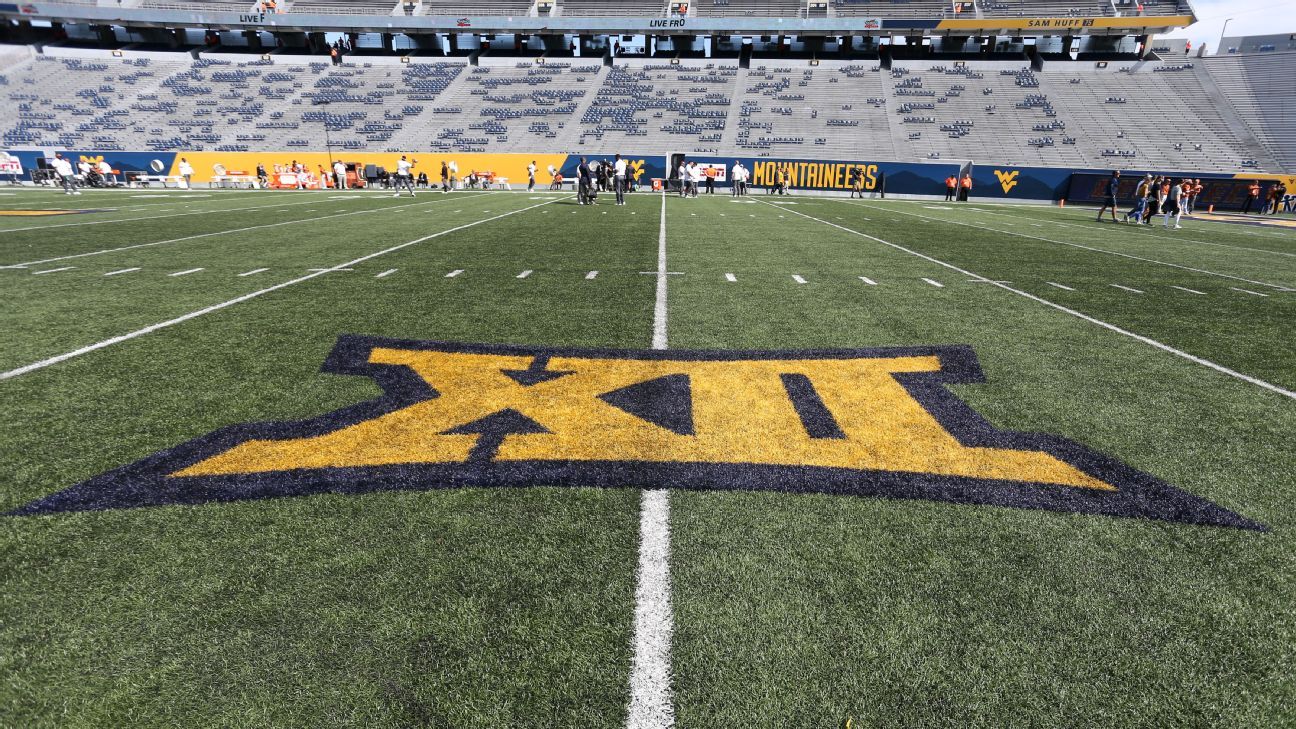A day after his league decided to proceed toward a fall football season, Big 12 commissioner Bob Bowlsby said the Big 12 was comfortable moving forward because its medical professionals haven’t indicated it’s unsafe to do so.
Just hours before the Big 12 presidents and chancellors met on Tuesday evening, two of the country’s Power 5 conferences — the Big Ten and Pac-12 — decided to postpone fall sports until 2021, but Bowlsby said the Big 12 voted to move forward cautiously until experts advise otherwise. The ACC and SEC made similar decisions on Tuesday.
Bowlsby did not disclose the vote or how discussions went, but said the board is “comfortable” with where they are. Asked about external pressure to shut down the season, Bowlsby said the league is well-informed.
“For the most part I have better information and my presidents have better information than most of our friends in the fourth estate,” Bowlsby said, referring to the media. “Reasonable people can disagree on it. The Pac-12 and the Big Ten are seeing much of the same information that we’re seeing. But our board believes in our scientists and has come to a conclusion that is different and so have the leadership of the SEC and the ACC.”
While much of the discussion Tuesday was focused on why the Big Ten and Pac-12 weren’t playing, Bowlsby was asked on Wednesday’s teleconference to explain the rationale for continuing to attempt to play in the midst of the coronavirus pandemic.
“Well the biggest argument [for playing] is that nobody has told us that it’s poorly advised to go forward and doing what we are doing,” Bowlsby said Wednesday. “If we get to the place where our doctors and scientists say, ‘You know what, you guys got two wheels off the tracks, and you’re headed for a train wreck,’ we will pivot that day.”
Regardless of the timing — whether it’s training camp, midseason or a week before the Big 12 championship game — Bowlsby said the conference will stop if doctors say they should.
“Making adjustments on the fly are going to be a part of this but our medical professionals have said, ‘Go forward, move slowly, make small adjustments, constantly be vigilant about changes in the environment,'” Bowlsby said. “That’s what we’re listening to … when they tell us otherwise we will be listening to that as well.”
Bowlsby was asked if the Big 12 would be willing to play alone if the SEC and ACC also eventually decided to push the sport to the spring.
“John Swofford and Greg Sankey and I spend a lot of time together, and we spend a lot of time comparing notes,” he said of the ACC and SEC commissioners, respectively. “I think it’s unlikely that we would diverge without fairly significant conversations in advance of it.”
Even though the commissioners of the Power 5 conferences communicate regularly, Bowlsby said that shouldn’t be mistaken for uniformity.
“In the end, I think we all have to do what’s best for our individual conferences,” Bowlsby said. “We’re not all similarly situated. In the case of the Pac-12, they’ve got a really tough situation in Southern California, two of their flagship schools there, and San Francisco’s been a hot spot off and on. Each league has to make its own decisions.
“When they made the decisions they made, certainly it causes us to look at the things they indicated were drivers for them, and we got to make our own assessments on those same criteria, what we have heard from our experts is that some of the ramifications of the virus can be mitigated and properly managed. As long as that continues to be the case, they believe that we can safely conduct competition and safely conduct practice. If we get to the place where it’s their considered opinion that we no longer could do that, then we will be able to pivot very quickly to another course.
“I think we can all talk to the same people, we can all look at the same data, we can all look at our own individual circumstances, and we can come to different outcomes,” Bowlsby said. “Obviously that’s what’s happening.”
Bowlsby said preemptively moving football to the spring didn’t make a lot of sense to him, for a multitude of reasons, including the fact that “it’s the tail end of the virus season.”
“I don’t think there’s a single indication that it could be a better situation in March, April and May than it is in September, October, November,” Bowlsby said. “The other thing is, if you start to play in March, that means you bring the players back and you start preseason camp, the last week of January, which is right in the teeth of the virus season. I think it all sounds good to move into the spring, but I don’t think there’s any indication that, that it’s any more certain in the spring than it would be in the fall.
“Having said that, as a fallback if we got disrupted or, or something happened that we couldn’t start the season, I think this spring is viable. I just don’t think it’s a first choice and I don’t think it’s something we do preemptively.”
One factor that the leagues which are committed to proceeding must monitor is the return of regular students to campuses. Bowlsby acknowledged that is going to provide a challenge after teams have been able to operate in a somewhat exclusive setting during voluntary workouts this summer.
Bowlsby referenced spikes in positive testing numbers when athletes returned to Big 12 campuses in June. Positive test rates have decreased significantly in the league since then.
“It’s a concern for our team doctors and for all sports medicine professionals, there’s no doubt about it,” Bowlsby said. “You have to think when 17-to-22 year-olds come back to campus there will be a lot of interactivity and I’m sure coaches are spending a lot of time talking to student-athletes about the implications of those interactions.”
Bowlsby said “several of our teams haven’t had a positive tests in weeks. And while he acknowledge they cannot create true “bubbles,” they’re doing their best to educate students about risk and minimizing exposure.
“Whether or not young people can discipline themselves to not go to parties where there are hundreds of kids in close contact and not be in crowded restaurants and the like,” he said. “You know you can’t stop living your life, but you also have to be smart about putting yourself in risky situations.”
Testing will be the key to minimizing outbreaks and the Big 12 announced Wednesday that it will require three tests per week in “high-contact” sports like football, volleyball and soccer. Bowlsby said for football, those tests are likely to be on Sundays, Wednesdays and Fridays and that non-conference opponents, of which all Big 12 schools can play one, will be expected to adhere to Big 12 testing standards.
The conference announced on Wednesday that it is also requiring EKGs, troponin blood tests, echocardiograms and cardiac MRIs as part of its return-to-play protocol for athletes who test positive for COVID-19. That requirement comes in the midst of concerns raised across the country about some athletes who have experienced myocarditis or have publicly stated that they’ve had heart complications after contracting the virus.
The fallout from each league’s decision also has a significant impact on the postseason, namely the College Football Playoff. Bowlsby, who is a member of the CFP management committee, said there is a playoff call next week, and all of this week’s changes will be discussed.
“It’s going to be a while into the season before all of that is resolved,” Bowlsby said. “We just are going to have to wait and see. There probably isn’t any obvious reason why it couldn’t work, to continue to try and play a postseason, but you’re also looking at a December-January time frame that’s right in the heart of the virus season. I just think it’s too early. We’re going to have to be patient, and wait and see what happens before we can answer those questions.”
The management committee, which is comprised of the 10 FBS commissioners and Notre Dame athletic director Jack Swarbrick, wrote the protocol for the committee to determine the four best teams. Bowlsby said with all of the changes that have happened, it’s likely those will have to be adjusted, too.
“It’s possible that those protocols will have to evolve out of necessity,” he said. “We certainly aren’t going to have the intersectional contests, interleague contests we have enjoyed in the past. There’s a lot of subjectivity in it, even under the best of circumstances. We put 13 honest people in a room and we asked them to do a very difficult job. I think actually their task is the same as it’s always been, they just don’t have as many tools available to them.”
Bowlsby was asked if it would be possible to award a spring champion and a fall one.
“You’ve asked a logical question, whether either one of them is actually a champion,” he said. “It’s a good question, but it’s unanswered at this point.”
Bowlsby was also asked Wednesday about Nebraska, which expressed a desire to play despite the Big Ten’s decision to postpone football. When asked if Nebraska has reached out to ask about the possibility of playing any Big 12 teams, Bowlsby said “they have not.”
Bowlsby also said “it’s not in any of our plans at the present time” to entertain adding temporary members to the league.


